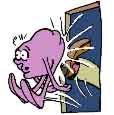Beta Decay
 I'm going to illustrate how radioactive decay works with the help of an isotope table applet,
which should now be open in a separate window. If it isn't, click here:
I'm going to illustrate how radioactive decay works with the help of an isotope table applet,
which should now be open in a separate window. If it isn't, click here:
 to open it now.
to open it now.
There are several ways in which radioactive atoms can decay. Here's one example: suppose an atom has
too many neutrons to be stable.That's the case with tritium, 3H1.
 Does it just kick out one of the neutrons?
Does it just kick out one of the neutrons?

 No, it can't do that; the neutrons are stuck too firmly where they are. What it can do...well,
I'll let you see for yourself. In the applet, click on the button labeled H3 (for hydrogen 3, or tritium).
No, it can't do that; the neutrons are stuck too firmly where they are. What it can do...well,
I'll let you see for yourself. In the applet, click on the button labeled H3 (for hydrogen 3, or tritium).
 The neutron turns into a proton! 3H1 becomes 3He2.
The neutron turns into a proton! 3H1 becomes 3He2.
 Right. An unstable isotope of hydrogen has converted itself into a stable isotope of helium.
You'll notice that 3H1 and 3He2 have the same mass number,
which is good, because mass has to be conserved.
Right. An unstable isotope of hydrogen has converted itself into a stable isotope of helium.
You'll notice that 3H1 and 3He2 have the same mass number,
which is good, because mass has to be conserved.
There is a problem, though. Electric charge also has to be conserved.
 Hydrogen has only one proton, and helium has two, so you'd end up with twice as much positive charge
as you started with. How do you get around that?
Hydrogen has only one proton, and helium has two, so you'd end up with twice as much positive charge
as you started with. How do you get around that?
 When 3H metamorphoses into helium 3, it also gives off an
electron--which has hardly any mass, and is endowed with a negative
charge that exactly cancels one proton. This process is known as beta decay, and the
electron is called a beta particle in this context.
When 3H metamorphoses into helium 3, it also gives off an
electron--which has hardly any mass, and is endowed with a negative
charge that exactly cancels one proton. This process is known as beta decay, and the
electron is called a beta particle in this context.







